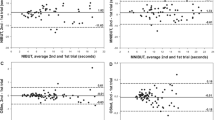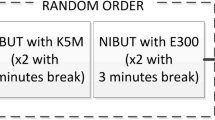Abstract
Purpose
To assess the reliability of a tear film (TF) viscosity video grading system.
Methods
Thirty-four dynamic TF viscosity videos were obtained by a clinically available TF analyzer and objectively sorted according to the movement speed of three arbitrary reflective light particles. A 4-grade system was constructed on a specially designed window for simultaneous comparison with the three standard videos. Two masked graders were invited to grade these videos under a randomized procedure. Observer reliabilities were determined by Spearman’s correlation analysis and Bland-Altman agreement analysis.
Results
For this four-grade system, the intra-observer correlation was very strong in the two graders (ρ = 0.96 and 0.82; both P < 0.0001). However, the inter-observer correlation showed moderate strength in normal playback speed (ρ = 0.53, P = 0.002 and ρ = 0.52, P = 0.003 for 1st and 2nd gradings, respectively). In slower playback videos, the inter-observer correlation of the two graders was higher (ρ = 0.70 and P < 0.0001) when reduced to 0.8-times playback speed. Moreover, the 0.8-times mode was also significantly better than normal playback mode (P = 0.0204) in terms of inter-observer agreement.
Conclusions
The dynamic 4-grade system has an excellent intra-observer reliability and a good inter-observer reliability under 0.8-times playback speed. The grading system established in this study provides a promising solution for rapidly determining the level of TF viscosity.






Similar content being viewed by others
Data availability
Data sharing not applicable to this article as no datasets were generated or analyzed during the current study.
Code availability
Not applicable.
References
Gipson IK (2007) The ocular surface: the challenge to enable and protect vision: the Friedenwald lecture. Invest Ophthalmol Vis Sci 48(4390):4391–4398. https://doi.org/10.1167/iovs.07-0770
Craig JP, Nichols KK, Akpek EK, Caffery B, Dua HS, Joo CK, Liu Z, Nelson JD, Nichols JJ, Tsubota K, Stapleton F (2017) TFOS DEWS II definition and classification report. Ocul Surf 15:276–283. https://doi.org/10.1016/j.jtos.2017.05.008
Lai HY, Kuo MT, Fang PC, Lin CC, Chien CC, Cho WH, Chen A, Lai IC (2019) Tracking the reflective light particles spreading on the cornea: an emerging assessment for tear film homeostasis. Transl Vis Sci Technol 8:32. https://doi.org/10.1167/tvst.8.3.32
Owens H, Phillips J (2001) Spreading of the tears after a blink: velocity and stabilization time in healthy eyes. Cornea 20:484–487
Varikooty J, Keir N, Simpson T (2012) Estimating tear film spread and stability through tear hydrodynamics. Optom Vis Sci 89:E1119–E1124. https://doi.org/10.1097/OPX.0b013e3182644cb7
Macchi I, Bunya VY, Massaro-Giordano M, Stone RA, Maguire MG, Zheng Y, Chen M, Gee J, Smith E, Daniel E (2018) A new scale for the assessment of conjunctival bulbar redness. Ocul Surf 16:436–440. https://doi.org/10.1016/j.jtos.2018.06.003
Schiffman RM, Christianson MD, Jacobsen G, Hirsch JD, Reis BL (2000) Reliability and validity of the ocular surface disease index. Arch Ophthalmol 118:615–621. https://doi.org/10.1001/archopht.118.5.615
Arita R (2018) Meibography: a Japanese perspective. Invest Ophthalmol Vis Sci 59:DES48–DES55. https://doi.org/10.1167/iovs.17-23631
Masmali AM, Purslow C, Murphy PJ (2014) The tear ferning test: a simple clinical technique to evaluate the ocular tear film. Clin Exp Optom 97:399–406. https://doi.org/10.1111/cxo.12160
Takeuchi T, Yoshimoto S, Shimada Y, Kochiyama T, Kondo HM (2017) Individual differences in visual motion perception and neurotransmitter concentrations in the human brain. Philos Trans R Soc Lond B Biol Sci 372:20160111. https://doi.org/10.1098/rstb.2016.0111
Turatto M, Vescovi M, Valsecchi M (2007) Attention makes moving objects be perceived to move faster. Vision Res 47:166–178. https://doi.org/10.1016/j.visres.2006.10.002
Manning C, Aagten-Murphy D, Pellicano E (2012) The development of speed discrimination abilities. Vision Res 70:27–33. https://doi.org/10.1016/j.visres.2012.08.004
Agyei SB, van der Weel FR, van der Meer ALH (2016) Development of visual motion perception for prospective control: brain and behavioral studies in infants. Front Psycho 7:100. https://doi.org/10.3389/fpsyg.2016.00100
Mac Cord Medina F, Silvestre de Castro R, Leite SC, Rocha EM, de Melo RG (2007) Management of dry eye related to systemic diseases in childhood and longterm follow-up. Acta Ophthalmol Scand 85:739–744. https://doi.org/10.1111/j.1600-0420.2007.00934.x
Arita R, Mizoguchi T, Kawashima M, Fukuoka S, Koh S, Shirakawa R, Suzuki T, Morishige N (2019) Meibomian gland dysfunction and dry eye are similar but different based on a population-based study: the Hirado-Takushima study in Japan. Am J Ophthalmol. 207:410–418. https://doi.org/10.1016/j.ajo.2019.02.024
Vu CHV, Kawashima M, Yamada M, Suwaki K, Uchino M, Shigeyasu C et al (2018) Influence of meibomian gland dysfunction and friction-related disease on the severity of dry eye. Ophthalmology 125:1181–1188. https://doi.org/10.1016/j.ophtha.2018.01.025
Murdoch IE, Morris SS, Cousens SN (1998) People and eyes: statistical approaches in ophthalmology. Br J Ophthalmol. 82:971–973. https://doi.org/10.1136/bjo.82.8.971
Kuo MT, Fang PC, Kuo SF, Chen A, Huang YT (2021) Tear proteomics study of dry eye disease: which eye do you adopt as the representative eye for the study? Int J Mol Sci. 22:422. https://doi.org/10.3390/ijms22010422
Acknowledgements
The authors thank Ming-En Hsieh, Institute of Data Science and Engineering, and Yi-Hsuan Lin, Institute of Computer Science and Engineering, Department of Computer Science, National Chiao Tung University, for their programming assistance in establishing the grading environment.
Funding
This work was supported by Chang Gung Research Proposal (CMRPG8J1091, CMRPG8K0111). The sponsors or funding organizations had no role in the design or conduct of this research.
Author information
Authors and Affiliations
Contributions
Conceptualization, MTK; methodology, HYL and MTK; validation, PCF and AC; formal analysis, HYL; investigation, HYL and PCF; resources, PCF and MTK; data curation, HYL; writing—original draft preparation, HYL; writing—review and editing, MTK and AC; visualization, HYL and AC; supervision, MTK; project administration, MTK; funding acquisition, MTK
Corresponding author
Ethics declarations
Ethics approval
Institutional review board/ethics committee approval (no. 201701393B0) was obtained from the committee of medical ethics and human experiments of CGMH.
Consent to participate
All participants and their legal representatives were clearly informed about the aim and procedure of this study and signed the informed consent.
Consent for publication
All authors have read and agreed to the published version of the manuscript.
Conflict of interest
The authors declare no competing interests.
Additional information
Publisher’s note
Springer Nature remains neutral with regard to jurisdictional claims in published maps and institutional affiliations.
The original version of this article was revised. ESM 1 is now corrected.
Supplementary information
Supplementary file 1
A simple grading application, video viewer. (PDF 228 kb)
Supplementary file 2
Operating instructions for the grading software. (PDF 316 kb)
Supplementary file 3
Demonstration of the grading scenario, in which the upper row of videos were video standards Q1, Q2, and Q3 (from left to right) and the lower row of videos were three copies of a graded video. (MP4 5400 kb)
Supplementary file 4
The Q1 standard video. (MP4 664 kb)
Supplementary file 5
The Q2 standard video. (MP4 567 kb)
Supplementary file 6
The Q3 standard video. (MP4 645 kb)

Supplementary 7
The Bland-Altman plots for analyzing intra- and inter-observer agreement of the tear film viscosity grading system at different playback speeds. (PNG 1111 kb)
Rights and permissions
About this article
Cite this article
Lai, HY., Fang, PC., Chen, A. et al. Grading reliability of the tear film viscosity examination. Graefes Arch Clin Exp Ophthalmol 259, 2287–2294 (2021). https://doi.org/10.1007/s00417-021-05176-2
Received:
Revised:
Accepted:
Published:
Issue Date:
DOI: https://doi.org/10.1007/s00417-021-05176-2




